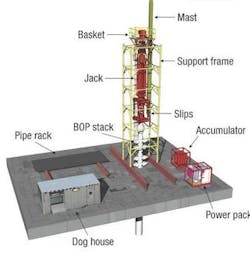Well intervention using rigless techniques
Sandeep Khurana
Brad DeWalt
Granherne Inc.
Colin Headworth
Subsea 7 Inc.
Subsea wells sharpen focus on methods
Rigless techniques for well intervention are wireline, coiled tubing (CT) and hydraulic workover (HWO) services that do not require the use of a conventional workover rig and have the capability of performing downhole applications in live (under pressure) wells.
Most well interventions are remedial operations performed on producing wells with the intention of restoring or increasing production. A well may require intervention due to flow restrictions, changes in reservoir characteristics, sand production, mechanical failure, or to access additional hydrocarbon pay zones. Downhole applications that are performed during well interventions include well surveillance and diagnostics, implementation of reservoir management techniques, completion repair and re-entry drilling to reach new producing intervals.
The choice of techniques and equipment to perform the downhole applications determines the mechanical and economic success of a well intervention job. A conventional workover rig comprising a derrick, rotary table, and heavy machinery can be used to perform well intervention. However, mobilizing an offshore rig and its associated support operations is expensive.
Downhole there is little difference in the tools that are deployed for dry (platform) wells versus subsea wells to remedy flow problems. But subsea well intervention in deepwater is typically much more expensive than dry well intervention due to the high day rates of floating vessels and the equipment costs of the subsea systems that are required to access the wellbore. The selection of the floating vessel and the subsea system is therefore critical.
null
In well intervention, downhole applications are performed in the wellbore to remedy production problems or otherwise increase production from the well. Most of these applications are typically a less complex version of well construction and completion phase work.
Coherent industry definitions for downhole applications relevant to well intervention are not readily available. Industry definitions as they exist today focus on the well construction and completion phase, and differ vastly based on major oil service providers' definition which is based on their packaged product service lines. To comprehend the scope of well intervention applications, 12 major categories are identified in downhole applications. These categories are well logging, perforating, well cleaning, fishing, fluid displacement, thru-tubing sand control, remedial cementing, selective stimulation, thru-tubing completions, artificial lift services, re-entry drilling, and surface controlled subsurface safety valve repair.
A single downhole application or multiple applications may be required to fully correct a well problem. Pulling of the production tubing is considered to be a major workover of a well requiring a conventional workover rig, and therefore is not included in the above applications.
The frequency of well intervention that will be performed during the life of a field is difficult to predict, since the decision to intervene in a well is dependent on numerous variables, including reservoir characteristics, infrastructure and economic considerations. Stimulation and remedial cementing/conformance applications are the most frequent reasons for well intervention. It is interesting to note that well intervention is most often performed to address reservoir specific issues, rather than to repair downhole mechanical equipment and completions.
Wireline
A wireline operation involves running and pulling tools and equipment into and out of the well by the use of a continuous-length, small-diameter solid or braided wire mounted on a powered reel at the surface. This can be done on a wellbore that is still under pressure. Typical wireline operations include perforating, logging, cleaning wells, and dumping cement. Most wireline surface equipment units are self-contained skids that consist of the wireline reel, power supply and associated control and connection equipment.
null
Coiled tubing
A CT operation involves inserting a continuous and a flexible steel pipe into a well bore to convey various well servicing tools and to circulate fluids. Steel coiled tubing is made from strips of high-strength steel that are rolled and seam welded. The tubing is flexible enough to be coiled onto a reel, with diameters that range from 3/4 to 3-1/2 in. Higher wall thicknesses and the development of new alloys have increased the strength of coiled tubing to allow it to withstand extreme pressure loadings and have improved its resistance to stress corrosion cracking. Advances are also being made in the area of light-weight composite coiled tubing.
CT surface equipment units are self-contained hydraulically powered workover units that provide substantial time and cost savings when compared to using a conventional workover rig. The major advantages that CT offers include:
- Faster running speeds into and out of a well since the operator does not have to stop to connect or disconnect each joint of pipe
- Reduced rig up and trip times
- Ability to continually circulate fluid through the pipe while the tubing is being lowered into and out of the hole
- Localized delivery of downhole fluids, increasing production tubing life and preventing contamination of acid from tubing scale
- Ability to work on live wells
- Ability to perform many wireline services can be performed in highly deviated and horizontal well bores by installing an E-Line inside coiled tubing.
Hydraulic workover
null
The advantages of using HWO over CT are that HWO can handle more complex jobs involving deeper reservoirs with higher pressures. HWO has the ability to use tapered pipe and can adjust the pipe length based on reservoir depth. HWO operations however are more costly than that of CT operations. The decision to use HWO instead of CT is dependant on the requirements of the specific application to be performed and the overall economical consideration. There are three basic categories:
- High pressure snubbing refers to pushing pipe into a well under pressure. This is an area where HWO competes with CT to perform work on live wells
- Hydraulic rig assist units assist conventional workover rigs and supplement the work performed by rigs to make the intervention job much more economical. By definition a rig assist unit is not a stand-alone type unit and operates only in conjunction with the workover rig
- HWO units have the ability to perform a major workover on the well, and compete directly with the work that is traditionally performed by conventional workover rigs. Major workover jobs typically involve the pulling of the production tubing for repairs.
Traditional approach
Traditionally, the subsea system has been a rigid workover riser package that provides direct access for the surface intervention equipment. The purpose of a workover riser is to extend the wellbore to the surface to provide well access at the full pressure rating and diameter of the downhole completion. The dynamic pressure seal between ambient and the wellbore is at the surface on the vessel.
A workover riser package consists of steel riser joints attached to the subsea tree through a subsea lower riser package (LRP), which includes blow out preventors (BOP). The workover riser components also include a subsea emergency disconnect package, stress joints, surface tree, circulating hose, control umbilical, control system, and associated running and test tools. The bore is made to match the completion size and is typically 4 or 5 in. nominal diameter. Depending on the system, a workover riser may also include a parallel riser for accessing the casing-tubing annulus of the well.
An HWO uses hydraulic cylinders to push jointed sections of pipe into the well, in contrast to the continuous tube used in CT.
A mobile offshore drilling unit (MODU) is usually selected for supporting subsea workover operations. Even if a conventional working rig is not required for wireline, CT and HWO, it is usually chosen for subsea well intervention because the rig on a MODU has the capability to handle workover risers using the same equipment that it uses for its drilling riser system. The use of a MODU for well intervention is often driven by availability in the field between well construction programs.
Alternate approach
Using floating vessels that are not MODU and that do not have marine drilling systems is recognized as an alternative approach for well intervention. This approach aims to optimize the pairing of subsea access methods with a floating vessel to achieve lower day rates for specific intervention capabilities.
The objective is to have substantially lower floating vessel day rates as compared to a MODU. However, this lower day rate typically comes with the penalty of less intervention capability as related to the following classifications:
- Light well intervention: typically a monohull with a free deck area of up to 10,000 sq ft that has the capability to perform wireline services using a subsea lubricator. This is also referred to as "riserless" intervention
- Medium well intervention: a semisubmersible or large monohull vessel with deck area of up to 30,000 sq ft. It is equipped to perform well intervention services and has the ability to handle rigid workover risers in deepwater.
- Heavy well intervention: a MODU for major well workover that requires a conventional rig to pull tubing strings or perform drilling operations This work is carried out using MODU that are either semisubmersibles or monohull vessels outfitted with marine drilling and hoisting equipment.
Smart well trends
In contrast to the well intervention market, investments have been made, particularly in smart well technologies, to approach the zero-intervention goal. Smart wells allow for real-time data gathering of downhole information. They can also include provisions to control production from various zones from a remote control center.
It should be noted that smart well technology has not seen widespread use yet. Issues related to complexity, reliability, and capital costs have led to a cautious attitude by operators in implementing such solutions, except in those cases where the benefits can be clearly established.
Interestingly, even though smart well technology normally works to reduce the need for well intervention. One aspect serves to compliment it. Having the data available from a smart well helps to build a more certain picture of the current status and any associated production problems with that well. Hence, the data gathered from a smart well gives greater certainty for selecting an appropriate and targeted intervention response.
An intervention service that is only capable of providing wireline, for instance, can be dispatched with greater certainty of success. Selection of a MODU solely to be prepared for any unexpected problems becomes less attractive, particularly if the specialized well intervention vessel offers significant cost-saving benefits.
Acknowledgements
The authors would like to thank Dean Fanguy (Baker Oil Tools), Perry Courville (Halliburton), John Misselbrook (BJ Services), Dr. Julie Morgan (Granherne), and Kurt Albaugh (BHP Billiton Petroleum) for their support and guidance on this article and Richard Curnow (Granherne) for sponsoring this work.



